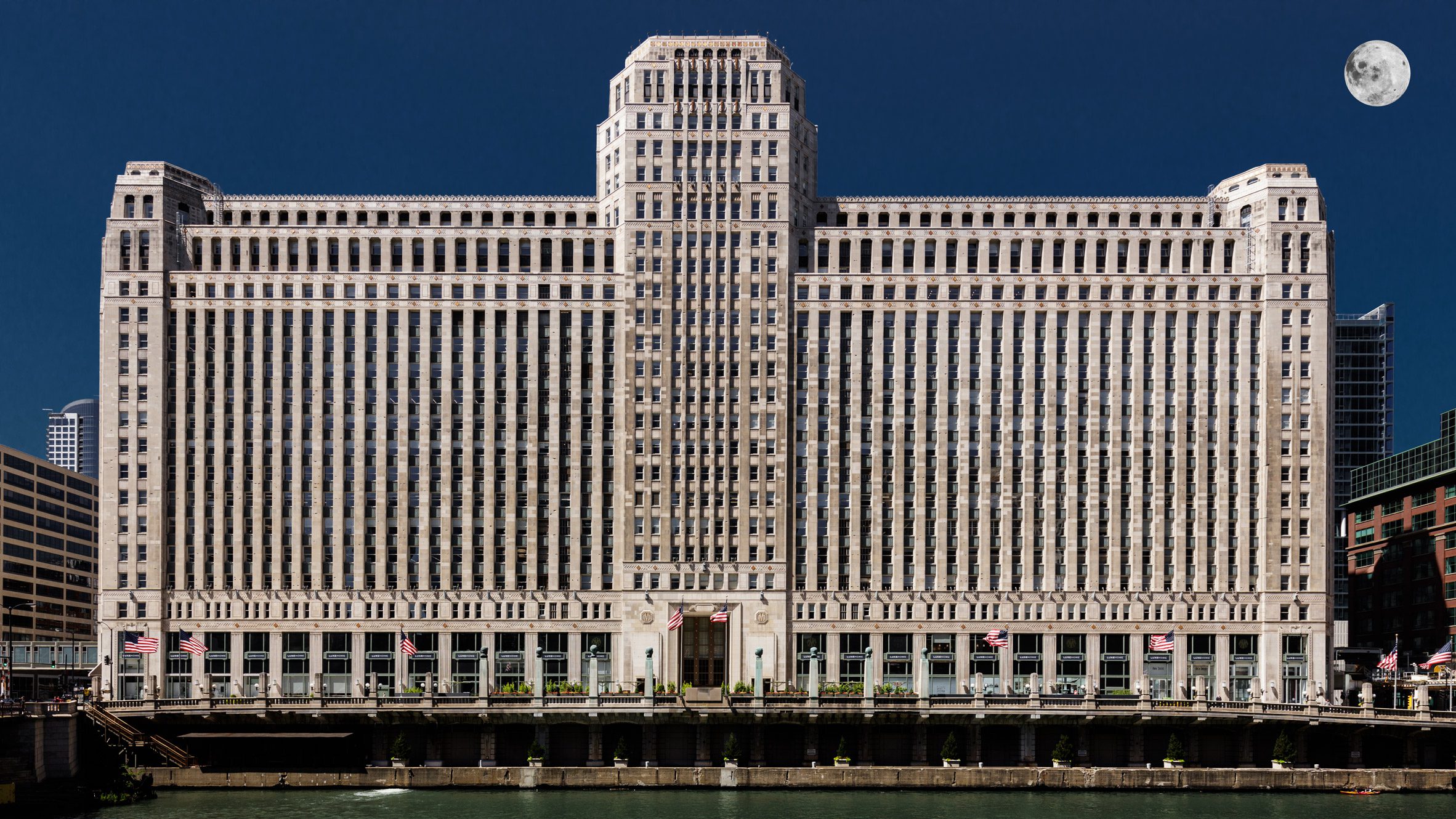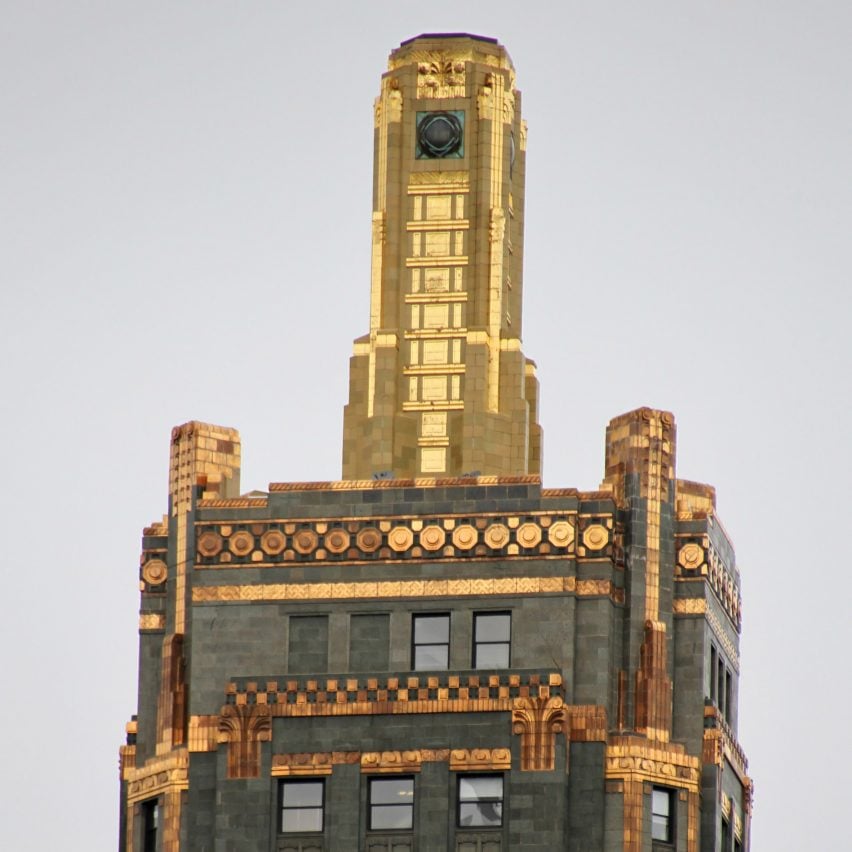As part of our ongoing Art Deco Centenary series, Dezeen rounds up 15 of the most noteworthy US examples of art deco architecture, from New York skyscrapers to an Oklahoma church.
After fully emerging in Paris in the early 1920s, art deco design was taken up enthusiastically by American architects, particularly during the 1930s.
In a recent piece for Dezeen, Bevis Hillier, the critic who popularised the term “art deco” in 1968, said that the “finest flowering” of the style occurred in American architecture.
Below, we have selected significant art deco buildings still standing today:

The Chrysler Building, New York City, by William Van Alen
Arguably the world’s most prominent example of art deco architecture, the Chrysler Building was completed in 1930 and is characterised by the concentric arches on its cap and car-centric ornamentation informed by its commissioner, Chrysler Corporation founder Walter Chrysler.
At the time of its construction on a corner plot in Midtown Manhattan, it vied for the title of world’s tallest building alongside 40 Wall Street and the Empire State Building, which were also under construction.
Technically the world’s first supertall skyscraper at over 300 metres, the Chrysler Building held the title for a year before being unseated by the completion of the 443-metre-tall Empire State Building in 1931.

Empire State Building, New York City, by Shreve, Lamb & Harmon
Still one of New York City’s most famous structures, the Empire State Building is recognisable for its tapered volume and elongated spire. Although classed as art deco, it does not have as much of the style’s defining ornamentation as the Chrysler Building, apart from its winged mast and reliefs of two eagles guarding its entrance.
According to the Art Deco Society of New York, the building’s design was informed by a pencil held aloft by the building’s developer, businessman John Jakob Raskob, when he demonstrated his vision of the building to architecture firm Shreve, Lamb & Harmon. Its famous terraced silhouette – typical of many skyscrapers built in the Big Apple around this time – was also a response to a zoning requirement introduced in 1916.
The building was completed in 1931 following a construction boom in New York City during the 1920s. At 443 meters tall (1,454 feet), it was the world’s tallest building until the first tower of the World Trade Center topped out in 1970.

Radio City Music Hall, New York City, by Edward Durell Stone and Donald Deskey
Built as part of the surrounding 22-acre art deco Rockefeller Center masterplanned by Raymond Hood and designed by architect Edward Durell Stone, the Radio City Music Hall theatre opened in 1932 and contained the world’s largest auditorium at the time, which is still home to the dance group The Rockettes.
The exterior is clad in the same Indiana limestone as the neighboring buildings of the Rockefeller Center, but Stone distinguished its facades with 27-metre-tall signage and ornamented fire escapes.
The theatre is perhaps best known for its tiered, clam-shell interior, outfitted with custom furnishings and upholstery by designer Donald Deskey.

Eastern Columbia Building, Los Angeles, by Claud Beelman
Located in Downtown Los Angeles, the Eastern Columbia Building is marked by its aqua-blue terracotta tiles, clock tower and slim Eastern logos wrapped around its crown.
Opened in 1930, the building originally served as a headquarters for the Eastern Outfitting Company and the Columbia Outfitting Company before it was eventually converted into residential lofts in 2006.
Its facade recently underwent restoration beginning in 2023, according to Los Angeles Conservancy. Los Angeles Times critic Christopher Hawthorne declared the building “one of the most beautiful pieces of architecture in the city”.

Griffith Observatory, Los Angeles, by John C Austin and Frederick M Ashley
Perched on the edge of Mount Hollywood in Griffith Park in Los Angeles, the Griffith Observatory was named after its benefactor Griffith J Griffith, an industrialist who left the money for the building in his will.
Opened in 1935, the building’s architecture mixes Greek and Beaux-Arts styles with art deco, most notably in its ornamented facade that also ties in Egyptian influences, as was popular during the art deco movement.
The building contains a planetarium, which is situated underneath its central dome, as well as the most looked-through telescope in the world, according to the Griffith Observatory.

The Carlyle, Miami Beach, by Richard Kiehnel
A Miami Beach mainstay, The Carlyle hotel is located on Ocean Drive, a beachside avenue in the South Beach that displays many of the city’s historic art deco buildings. Opened in 1941, it is a late example of art deco.
Its broad facade is marked by sun shades that curve around its corners, while three pilasters run up through the centre, interlaced with decorative screens. This distinctive facade also doubled as the exterior of the Birdcage Hotel in the 1996 movie The Birdcage.
It is located in the National Register Miami Art Deco District, a district protected by the Miami Design Preservation League, which is the largest collection of art deco buildings in the world and is further characterised by Miami’s local styles, such as tropical deco.

The Colony Hotel, Miami Beach, by Henry Hohauser
Another colourful hotel on Ocean Drive, The Colony Hotel was completed in 1935 by architect Henry Hohauser, who oversaw the design of more than 300 buildings in Miami Beach.
Considered to be one of the first art deco buildings in the area built after a damaging 1926 hurricane, its storied history saw musicians such as Frank Sinatra, Dean Martin, and Sammy Davis Jr visit during the 1960s and 70s.
The building’s facade is marked by its bold hotel signage and horizontal overhangs, which are illuminated with blue neon at night.

Carbide & Carbon Building, Chicago, by Burnham Brothers
Located in the Loop of Chicago and completed in 1929, the Carbide & Carbon Building “epitomizes the lavish excitement of art deco” according to the Chicago Architecture Center.
The 37-storey building is clad in black granite, green and gold terracotta tiles and topped with a tiered spire ornamented with 24-karat gold.
Today, the building contains the Pendry Hotel, but it was originally designed as a headquarters for the battery company The Carbide and Carbon Company, which sought to “make a statement” with the building.

The Merchandise Mart, Chicago, by Graham, Anderson, Probst and White
Completed in 1930, the sprawling four-million-square-foot Merchandise Mart building in Chicago was originally designed to be a “city in a city” and was the largest building in the world upon its completion.
According to Britannica, the building was conceived by Graham, Anderson, Probst and White designer Alfred Shaw as a confluence of a warehouse, a department store and a skyscraper, represented by the building’s central tower.
Recently, the building underwent a series of renovations spearheaded by US studio Gensler that sought to preserve the building’s art deco detailing.

The Penobscot Building, Detroit, by Wirt C Rowland
Designed by local architect Wirt C Rowland and opened in 1929, the tiered Penobscot Building was Detroit’s tallest building at 566 feet high (173 metres) for over four decades before the Renaissance Center opened in 1977.
Its exterior is adorned with “Native American motifs” and was also named after the Penobscot tribe of Maine, according to Historic Detroit, as the building’s developer spent time working on the Penobscot River in his youth.
A glowing red orb atop the building served as an aviation beacon historically and is now illuminated during holidays.

The Guardian Building, Detroit, by Wirt C Rowland
Opened in 1929, the Guardian Building was designed to be a headquarters for the Union Trust Company.
The 40-storey building is clad in an unusual orange brick, eventually dubbed Guardian Brick by its manufacturer, and was the world’s tallest masonry structure when it was completed, according to Historic Detroit.
The building also features a colourful and elaborate interior, with brightly coloured tiles covering a grand archway.

Kennedy-Warren Apartment Building, Washington DC, by Joseph Younger
According to the DC Preservation League, the Kennedy-Warren Apartment Building was considered to be one of “the largest and most architecturally significant apartment buildings” in Washington DC upon the completion of its main building in 1931.
Its facade boasts a number of motifs specifically informed by Aztec culture, as well as a curving aluminium canopy lined with small decorative arches.
Construction was halted by the Great Depression, and the building was built in phases until 2004, now containing 425 apartments.

The Paramount Theatre, Oakland, by Timothy Pflueger
Designed by San Francisco architect Timothy Pflueger, “the region’s art deco master”, the Paramount Theatre opened in 1931 as a movie palace – an elaborately decorated movie theatre typology that saw a rise in the 1920s.
Its distinctive facade features vertical, metallic siding and a mosaic of two oversized figures overlooking a variety of performers, which was based on a painting by an artist working at Pfluger’s studio, Miller and Pflueger, according to the Pacific Coast Architecture Database.
Upon its opening, it was the largest theatre on the West Coast with a capacity of 3,476. In the 1970s, it was converted into a performing arts centre and now hosts music, dance and theatre events.

Boston Avenue United Methodist Church, Tulsa, by Adah Robinson and Bruce Goff
Completed in 1929 and designated a National Historic Landmark in 1999, the Boston Avenue United Methodist Church sits on the edge of downtown Tulsa, Oklahoma.
It is known as one of the few art deco buildings designed by a woman, artist Adah Robinson, although this remains a local controversy as some argue her former student Bruce Goff is the true designer.
Its ornamented limestone facade is marked by golden figures above its entrance and a spire that represents “two hands raised upward in prayer”, according to the church.

Hoover Dam, Boulder City, by Gordan Kaufman and John L Savage
Named after president Herbert Hoover, the Hoover Dam is located outside of Las Vegas and spans the Arizona and Nevada state line above the Colorado River.
Built during the Great Depression from 1931 to 1936, today the dam controls the flood of the river, irrigates more than 1.5 million acres of land, and provides water to more than 16 million people across urban centres including Los Angeles, while electrifying more than 500,000 homes through hydro-eletric power, according to the Herbert Hoover Presidential Library and Museum.
John L Savage served as its chief engineer, while Southern California architect Gordan Kaufman took over its styling, ornamenting the dam’s intake towers and other elements with art deco motifs such as repeating patterns and metallic accents. Kaufman also recruited artist Allen True and sculptor Oskar J W Hansen for the project, who added decorative interior tiling and statues of tall winged figures on the exterior, respectively.

Art Deco Centenary
This article is part of Dezeen’s Art Deco Centenary series, which explores art deco architecture and design 100 years on from the “arts décoratifs” exposition in Paris that later gave the style its name.
The post Fifteen of America's most significant art deco buildings appeared first on Dezeen.

